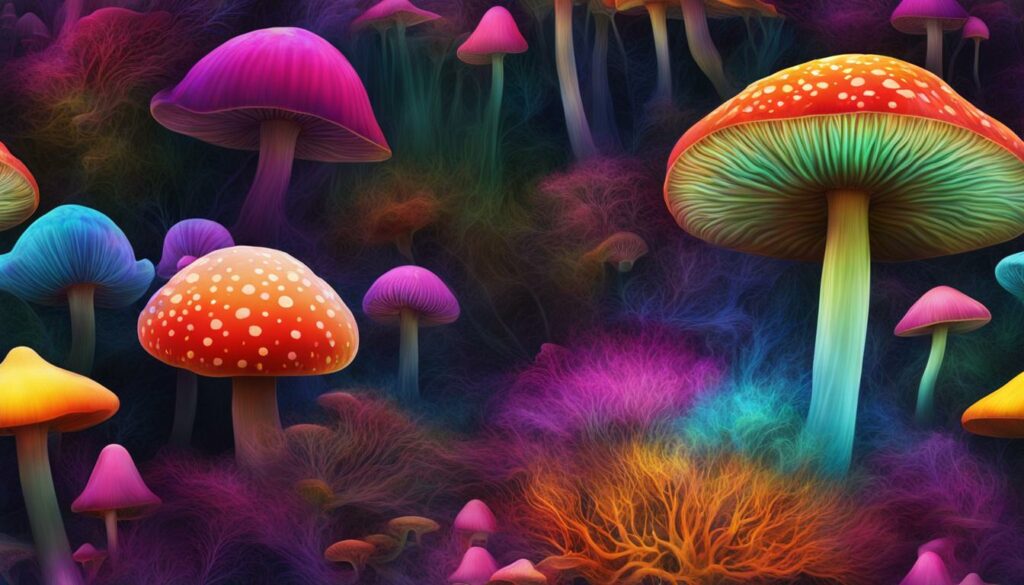Shrooms, also known as magic mushrooms, have gained popularity for their psychedelic effects on the mind and body. If you’re considering trying shrooms or have already experienced their effects, it’s important to understand how long they last in your system. This knowledge can help you make informed decisions and plan accordingly.
When ingested, shrooms contain the compound psilocybin, which is metabolized into psilocin. It is psilocin that produces the hallucinogenic effects associated with shroom use. The duration of these effects can vary depending on several factors, including dosage, individual metabolism, and the type of mushroom consumed.
The effects of shrooms typically last for 4-6 hours, with the peak occurring around 2-3 hours after ingestion. During this time, users may experience visual hallucinations, mood changes, and alterations in perception. It’s important to note that each person’s experience may differ, and the intensity of the effects can vary.
After the effects wear off, how long do shrooms stay in your system? The presence of psilocin can be detected in urine samples for up to 24 hours after ingestion, and in some cases, up to 72 hours in heavy or chronic users. Blood tests can detect psilocin for up to 6 hours, while hair tests can identify the presence of the drug for several months or even years, depending on the length of hair analyzed.
It’s crucial to be aware of these detection windows, especially if you’re subject to drug testing, as shrooms are generally prohibited in most countries. Additionally, shroom use can have potential risks, including nausea, vomiting, paranoia, anxiety, and potentially dangerous behavior. Even though shrooms may provide unique experiences, it’s essential to prioritize your safety and well-being.
Key Takeaways
- The effects of shrooms can last for 4-6 hours, with peak effects occurring around 2-3 hours after ingestion.
- Psilocin, the metabolite of psilocybin, can be detected in urine samples for up to 24 hours after ingestion and in heavy or chronic users, up to 72 hours.
- Blood tests can detect psilocin for up to 6 hours, while hair tests can identify the presence of the drug for several months or even years.
- Shroom use can have potential risks such as nausea, vomiting, paranoia, anxiety, and potentially dangerous behavior.
- It’s crucial to prioritize your safety and well-being when considering shroom use or if you’re experiencing addiction-like symptoms.
How Shrooms Interact with the Body
When it comes to understanding the effects of shrooms, it’s essential to delve into how these mystical fungi interact with the human body. Shrooms contain a compound called psilocybin, which the body metabolizes into psilocin. This conversion is a crucial step that sets off a chain reaction of effects within the body.
Psilocin, the active metabolite, interacts with serotonin receptors in the brain. These receptors play a role in mood, perception, and mental processes. The binding of psilocin to the 5-HT2A receptors results in a cascade of effects, including visual hallucinations, changes in mood, and an altered sense of reality.
One area of the brain that is particularly affected by psilocin is the prefrontal cortex. This region, responsible for planning and judgment, becomes more active when psilocin binds to the serotonin receptors. As a result, individuals may experience changes in their perception of time, space, and reality.
The interaction between psilocin and serotonin receptors can lead to increased brain connectivity and a more integrated state of consciousness.
The Impact on Perception and Reality
The effects of shrooms on perception and reality are profound. Visual hallucinations, altered colors, and patterns may be experienced, making the world seem vibrant and unpredictable. Perception of time can become distorted, with minutes feeling like hours, or hours passing by in the blink of an eye.
Furthermore, shrooms have the potential to induce mood changes, leading to a heightened sense of euphoria, introspection, or even anxiety and paranoia in some individuals. These changes in perception and mood can contribute to the transformative and, at times, spiritual experiences reported by shroom users.
Increased Brain Connectivity and Serotonin Receptor Activity
Recent research suggests that psilocybin, the active component in shrooms, has the potential to increase connectivity across different brain regions. This increased connectivity can result in a more integrated state of consciousness, where different parts of the brain communicate and work together in unique ways.
Moreover, psilocin’s interaction with serotonin receptors alters their activity, leading to significant shifts in perception and consciousness. By modulating serotonin receptor activity, shrooms have the potential to create profound and long-lasting changes in the brain that may have therapeutic implications for conditions such as depression, anxiety, and addiction.
In the next section, we will explore the factors that influence how long shrooms stay in the system and the various methods used to detect their presence.
How Long Do Shrooms Stay in Your System – Factors and Detection
The duration of shrooms in your system can vary depending on several factors. These factors include age, weight, dose, metabolism, type of mushroom, and method of ingestion.
Age: Younger individuals may metabolize shrooms more quickly than older individuals, leading to a shorter duration of effects in their system.
Weight: Heavier individuals may have a slower metabolism, resulting in shrooms staying in their system for a longer period of time.
Dose: Higher doses of shrooms can lead to a longer duration of effects and a longer detection window.
Metabolism: Individuals with a faster metabolism may process shrooms more quickly, resulting in a shorter duration of effects in their system.
Type of Mushroom: Different species of mushrooms can contain varying levels of psilocybin, which can affect the duration of effects and detection windows.
Method of Ingestion: The method of ingestion, such as eating shrooms directly or brewing them into a tea, can impact how quickly the effects are felt and how long they last.
There are several methods of detecting the presence of shrooms in the body. Urine testing is commonly used and can detect psilocin, the metabolite of psilocybin, for up to 24 hours after ingestion. Blood testing can detect psilocin for up to 6 hours, while hair testing can detect its presence for several months or even years, depending on the length of hair analyzed.
| Factor | Affected Duration |
|---|---|
| Age | May impact metabolism and the duration of effects |
| Weight | Heavier individuals may have a longer duration of effects |
| Dose | Higher doses can lead to a longer duration of effects |
| Metabolism | A faster metabolism may result in a shorter duration of effects |
| Type of Mushroom | Different mushrooms may have varying levels of psilocybin, impacting the duration of effects |
| Method of Ingestion | The method of ingestion can affect how quickly the effects are felt and how long they last |
It’s important to note that routine drug tests or workplace drug tests typically do not screen for shrooms. However, there are specialized drug tests available that can detect the presence of psilocin in the body if necessary.
The Effects and Risks of Shroom Use
Using shrooms, also known as magic mushrooms, can result in various effects on the body and mind. These effects include hallucinations, mood changes, and alterations in perception. When consuming shrooms, users may experience visual hallucinations, changes in mood, and sensory distortions. The intensity of these effects can range from slight sensory distortions to profound spiritual experiences, depending on the dosage and an individual’s mindset.
However, it’s important to recognize that shroom use also comes with risks. Some common side effects include nausea, vomiting, paranoia, anxiety, and potentially dangerous behavior. These adverse reactions can vary from person to person and are influenced by factors such as the individual’s mental state, dose, and surroundings.
Shroom use can lead to various effects such as hallucinations, mood changes, and alterations in perception.
It’s crucial to understand that shrooms are classified as a Schedule I controlled substance in the United States. This classification indicates that they are considered to have no recognized medicinal value and a high potential for abuse. As a result, the use, sale, and distribution of mushrooms are generally prohibited in most countries.
Considering the potential risks and legal implications, it’s important to approach shroom use with caution and make informed decisions. If you or someone you know is struggling with shroom use or experiencing addiction-like symptoms, seeking professional assistance and support is crucial for addressing any potential issues and ensuring personal well-being.

| Effects of Shroom Use | Risks of Shroom Use |
|---|---|
| Hallucinations | Nausea |
| Mood changes | Vomiting |
| Alterations in perception | Paranoia |
| Anxiety | |
| Dangerous behavior |
Conclusion
Shrooms, also known as magic mushrooms, can have various effects on the body and mind. The duration of these effects can last for 4-6 hours, with peak effects occurring around 2-3 hours after ingestion. It’s important to be aware of the risks associated with shroom use, including nausea, vomiting, paranoia, anxiety, and potentially dangerous behavior.
If you or someone you know is struggling with shroom use or experiencing addiction-like symptoms, it’s crucial to seek professional assistance and support. Shroom addiction is a real concern, and seeking help is the first step towards recovery. Qualified professionals can provide guidance, counseling, and treatment options tailored to individual needs, ensuring a safe and supportive journey towards a healthier lifestyle.
Remember, you don’t have to face shroom addiction alone. Reach out to organizations and helplines dedicated to substance abuse for information, resources, and support. Seeking professional assistance can make a significant difference in your journey towards a life free from shroom addiction.
FAQ
How long do shrooms last in your system?
The effects of shrooms can last anywhere from 4-6 hours, with peak effects occurring around 2-3 hours after ingestion.
How long can psilocin, the metabolite of psilocybin, be detected in urine?
Psilocin can be detected in urine samples for up to 24 hours after ingestion, and in some cases, up to 72 hours in heavy or chronic users.
How long can psilocin be detected in blood?
Blood testing can detect psilocin for up to 6 hours after ingestion.
How long can psilocin be detected in hair?
Hair testing can detect psilocin for several months or even years, depending on the length of hair analyzed.
What are the risks associated with shroom use?
Shroom use can pose risks such as nausea, vomiting, paranoia, anxiety, and potentially dangerous behavior while under the influence.
Are shrooms legal?
Most countries, including the US, prohibit the use, sale, and distribution of mushrooms. They are classified as a Schedule I controlled substance.
What should I do if I’m struggling with shroom use or addiction-like symptoms?
It’s important to seek professional assistance and support. There are resources available to help you overcome addiction and address any underlying issues.




